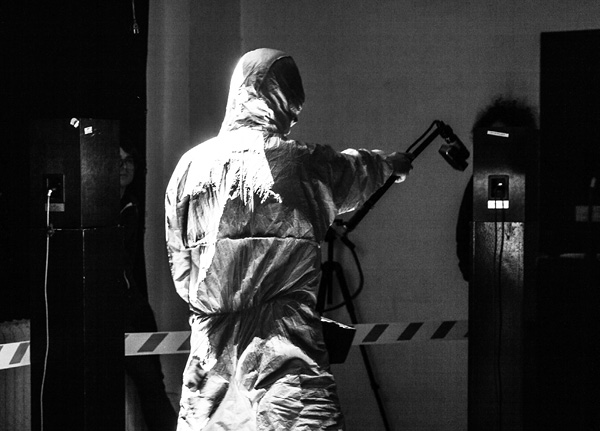
QUANTUM ENIGMA
first performed on April 5, 2016
Harvestworks Media Art Center NYC, New York, NY
performed three times in 2016
ROBERT B LISEK
Wroclaw, Poland / New York, NY
116260702l116260702i116260702s116260702e116260702k116260702@116260702f116260702u116260702n116260702d116260702a116260702m116260702e116260702n116260702t116260702a116260702l116260702.116260702a116260702r116260702t116260702.116260702p116260702l
fundamental.art.pl
QUANTUM ENIGMA
ROBERT B LISEK
“Quantum Enigma” consists of an action, the goal of which is to extend the notion of art by dealing with randomness. I reveal the process of radioactive decay as the best and strongest manifestation of the idea of randomness. I have chosen thorium as a medium for its state as a radioactive material, which is the source of fundamental random processes not usually associated with art. Thorium is a source of dispersion and real disorder. The use of thorium is to use raw material which is not subject to the power of will. The real performative element contained in the action reveals the pure process of decay and energy emission.
STAGE 1. Superposition of states
In the first stage I present radioactive material sealed within a leaden container. A superposition of states, in which the particles remain within the container, happens without the observer having any access to the processes occurring. A potential transitional space emerges, consisting of particles that remain in a superposition of numerous states. If we interpret the formulas of quantum mechanics, we can say that the particles in the container do not exist in any particular place. They exist in many places simultaneously with a certain probability of occurrence. This is an example of pure potential, which encompasses many different setups, including many past and future works of art and music compositions.
STAGE 2. Randomness
The second stage of the action begins with opening the container and applying the probe of a Geiger counter to it. Gamma radiation, which has a completely random character, is detected. During the decay of radioactive particles it is impossible to predict which particles will be “shot,” and when. The Geiger counter produces a series of successive clicks, signaling the shooting of particles by the radioactive source. The moment in which a click occurs is completely unpredictable. The time between successive clicks is always different. This unpredictability indicates primal randomness existing in reality on a quantum level, which means there is no deterministic explanation of what is happening. The use of the Geiger counter enables the printing of the sequence of random numbers, which is subsequently concentrated by sounds or light impulses and presented in the form of an installation. In the moment of applying the probe of the Geiger counter, there is a transition from the phase of superposition to the phase of recognizing randomness. The potential space consisting of the superposition of numerous states is collapsed to a precise sequence of light-sound impulses, which can be perceived by the senses. The speed of clicks has significant importance and can be controlled by bringing the probe closer to the radioactive source or scaling the metro (sampling frequency) in the computer program (written by me). The original program is used for reading the frequency of the clicks, amplifying the signal, and presenting it in the form of light-sound impulses.